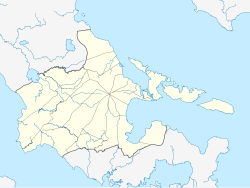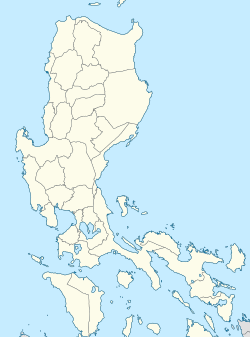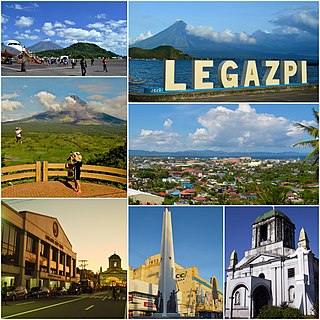
Legazpi, officially the City of Legazpi, is a 1st class component city and capital of the province of Albay, Philippines. According to the 2020 census, it has a population of 209,533. Legazpi is the regional center and largest city of the Bicol Region and in Albay, in terms of population. It is the region's center of tourism, education, health services, commerce and transportation in the Bicol Region. The city is applying for a Highly Urbanized City (HUC).
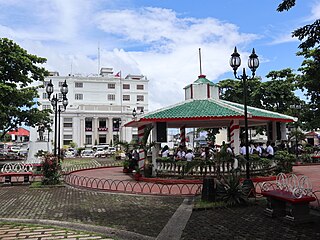
Tabaco, officially the City of Tabaco, is a 4th class component city in the province of Albay, Philippines. According to the 2020 census, it has a population of 140,961 people.

Polangui, officially the Municipality of Polangui, is a 1st class municipality in the province of Albay, Philippines. According to the 2020 census, it has a population of 89,176 people.

The Minor Basilica of Saint Michael the Archangel, commonly known as Tayabas Basilica, is a Roman Catholic basilica located in Tayabas, Quezon, Philippines, under the Diocese of Lucena. Its titular saint is Michael the Archangel, whose feast is celebrated every September 29.

The Cagsawa Ruins are the remnants of a 16th-century Franciscan church, the Cagsawa church. It was originally built in the town of Cagsawa in 1587 but was burned down and destroyed by Dutch pirates in 1636. It was rebuilt in 1724 by Fr. Francisco Blanco but was destroyed again, along with the town of Cagsawa, on February 1, 1814, during the eruption of Mayon Volcano.
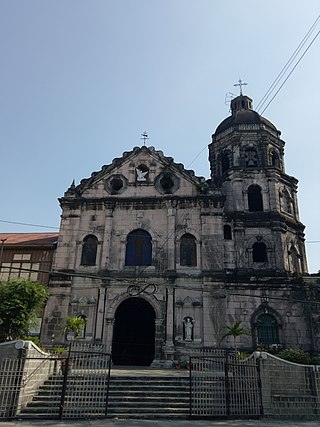
The National Shrine of Our Lady of the Abandoned, also known as Santa Ana Church, is a Spanish colonial period Roman Catholic church located in the district of Santa Ana in Manila, Philippines. It is under the jurisdiction of the Archdiocese of Manila. The parish was established by the Franciscan missionaries in 1578 under the patronage of Saint Anne. The present stone church was constructed by Vicente Inglés from 1720 to 1725 and was dedicated to its present patron, the Our Lady of the Abandoned. The revered image of its patron was made in Valencia, Spain in 1713 and arrived in the Philippines in 1717.

The Minor Basilica and Archdiocesan Shrine Parish of Saint Anne, commonly known as Santa Ana Church, is a Roman Catholic church and minor basilica located in Barangay Santa Ana, Taguig, Philippines. It is under the jurisdiction of the Diocese of Pasig. The church is situated next to the Taguig River and across Plaza Quezon, where the statue of Manuel L. Quezon was erected during his tenure as President of the Philippines. Saint Anne is the patroness of the church.

Saint Gregory the Great Parish Church, commonly known as Majayjay Church, is one of the oldest Roman Catholic churches in the Philippines located in the municipality of Majayjay in Laguna. It is under the jurisdiction of the Diocese of San Pablo. The church is recognized by the National Museum as a National Cultural Treasure.

Saint James the Apostle Parish Church, commonly known as the Church of Paete, is the only Roman Catholic church in Paete, Laguna, Philippines. Its patron saint is James the Apostle and his feast is celebrated every July 25. It is under the jurisdiction of the Diocese of San Pablo. The church is known for its huge and exquisite collection of images depicting the Passion of Christ, its century-old paintings and wooden images of saints.

Saint Augustine Parish Church is the only Augustinian Roman Catholic church in Bay, Laguna, in the Philippines. It is under the jurisdiction of the Diocese of San Pablo. The church was first administered by Augustinian friars and later transferred to the Franciscans.

San Bartolome Apostol Parish Church, also known as Saint Bartholomew the Apostle Parish Church, is a Roman Catholic church in Nagcarlan, Laguna, Philippines. Its titular saint is Bartholomew and its feast day is celebrated every August 24. The church is under the jurisdiction of the Diocese of San Pablo.

The Cathedral Parish of Saint Paul the First Hermit, commonly known as San Pablo Cathedral, is the see of the bishop of the Roman Catholic Diocese of San Pablo located in San Pablo, Laguna, Philippines. Its titular is Saint Paul the First Hermit and its feast is celebrated every January 15.

San Sebastian Parish Church, commonly known as Lumban Church, is a Roman Catholic church in Lumban, Laguna, Philippines. Its titular is St. Sebastian and its feast is celebrated every January 20. It is under the jurisdiction of the Diocese of San Pablo. The first tabernacle outside Manila was inaugurated in Lumban including the first Eucharistic Procession outside of Manila. The Franciscans established the first School for Church Music in the country in this town under Juan de Santa Maria. Today, the church is under the pastoral care of the Clerical Congregation of the Missionaries of Faith.
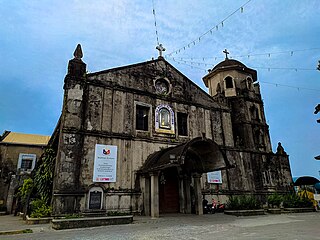
The Diocesan Shrine and Parish of Our Lady of Candelaria, commonly known as Silang Church, is a Roman Catholic parish church in the municipality of Silang, in the province of Cavite, Philippines under the Diocese of Imus. Its titular is the Our Lady of Candelaria. The church is known for its Spanish colonial architectural style and the rococo-influenced retablos. It is the oldest existing stone church in the province of Cavite, having been completed in 1639.

Our Lady of the Gate Parish Church, also known as Nuestra Señora de la Porteria Parish Church and commonly known as Daraga Church, is a Roman Catholic church in the municipality of Daraga, Albay, Philippines under the jurisdiction of the Diocese of Legazpi. The church was built by the Franciscans in 1772 under the patronage of the Our Lady of the Gate. Certain church sections were declared as a National Cultural Treasure of the Philippines in 2007.

Immaculate Conception Parish Church, commonly known as Guiuan Church, is a Roman Catholic church in the municipality of Guiuan, Eastern Samar, Philippines, within the jurisdiction of the Diocese of Borongan.
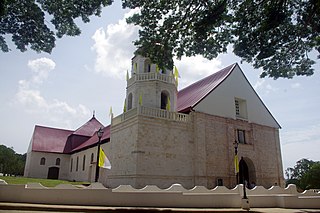
San Isidro Labrador Parish Church, commonly known as Lazi Church, is a Roman Catholic church in the municipality of Lazi, Siquijor, Philippines within the jurisdiction of the Diocese of Dumaguete. It became an independent parish in 1857 under the advocacy of Saint Isidore the Laborer.

Saint Ignatius of Loyola Parish Church, commonly known as Capul Church or Fuerza de Capul, is a Roman Catholic fortress church in the municipality of Capul, Northern Samar, Philippines within the jurisdiction of the Diocese of Catarman. It was first established as a mission station by the Jesuits in 1596 under the advocacy of Saint Ignatius of Loyola.

Saint Gregory the Great Cathedral Parish, commonly known as Legazpi Cathedral and locally as Albay Cathedral, is a Roman Catholic cathedral dedicated to Saint Gregory the Great in the Old Albay District of the city of Legazpi, Albay, in the Bicol region of the Philippines. It is the seat of the Diocese of Legazpi. In 2018, a historical marker of the National Historical Commission of the Philippines was unveiled at the cathedral.

